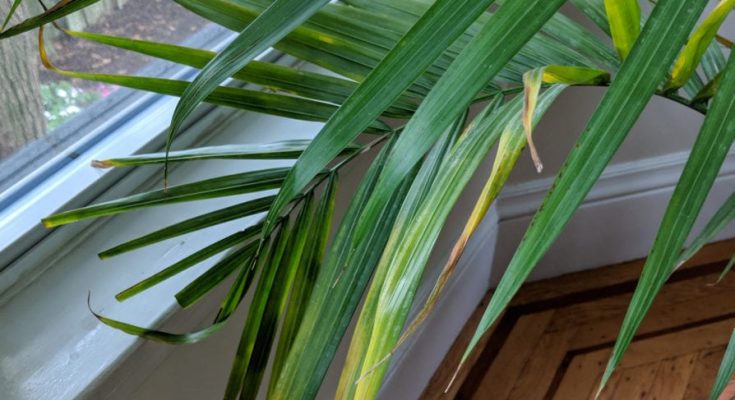The most common question we get asked about Majesty Palms is why their fronds are turning brown or yellow. Majesty Palms are indigenous to Madagascar and they do best when their environment mimics the natural sunlight and moisture they would receive there. This palm is an outstanding indoor plant adding a bit of tropical flair to any living space. However, when placed in a very low light and dry conditions its health will deteriorate since that is not the best environment for its long-term well being.
Potential Cause: Improper Light
Soaking up intermittent sunlight is ideal for a Majesty Palm, but long direct sunshine will cause a burn. Find a medium to a bright indirect lit area that will provide adequate light levels for long-term survival.
How to fix it:
This palm can adapt to a bit of lower light. However, if the light is too dark the growth will slow down and eventually, all the plant’s energy will go to new producing new leaves letting the lowest and oldest leaves yellow and wither away.
Potential Cause: Inadequate Moisture
Consistent soil moisture for the Majesty is vital to maintaining a healthy appearance and keep the leaves green. Do not let the palm become too dry, the soil should be kept continuously damp.
How to fix it:
Misting can greatly increase the humidity. Low humidity and dry soil will cause the tips to turn brown and eventually the leaf will be entirely yellow.
Potential Cause: Nutrient Deficiency
Majesty Palms will benefit from fertilizing a couple of times a year.
How to fix it:
It is a good idea to fertilize your Majesty Palm a couple of times in the spring and summer months. Find a plant food that contains iron. It is also a good idea to supplement with Epsom salts to provide adequate magnesium. Lack of magnesium often causes yellowing.
Potential Cause: Pests
Weakened or stressed Majesty Palms become more susceptible to insects. Especially sap-sucking bugs like spider mites and mealy bugs that drain the palm of moisture which causes yellowing. If not dealt with early on, these small pests flourish and move along the entire plant particularly when the palm is unhealthy from poor lighting, inadequate moisture, and a nutrient deficiency.
How to fix it:
Periodically inspect your plants checking both the top and bottom of leaves as well as stems. Insect infestations are easy to treat. Use a neem oil product designed for houseplants. Or, the homemade remedy of putting a tablespoon or two of baking soda and a teaspoon or two of mineral oil in a spray bottle of water. Shake the solution well and then spray all areas of the plant that are infected. Keep infected plants away from your other houseplants. Take your plant outside if possible, as the neem oil has an unpleasant smell that lingers. Wait two weeks, inspect again, then repeat the spraying process if needed.
Grow-How™ Note:
We suggest always removing the damaged area of a leaf or the complete leaf if entirely brown. Removal of the dead leaf or damaged areas helps the plant recover and look its best. You will need very sharp scissors or pruning shears.
Instructions for proper removal of damaged or dead leaves:
1. Trim off brown leaf tips or spots with clean shears. Cut off only the damaged tips or spots leaving a tiny margin of brown so not to damage the remaining healthy foliage on the plant.
2. If the entire leaf has turned brown, remove individual leaves at their base. Pull the leaf gently; it may come off on its own. If the leaf doesn’t separate with gentle pulling, snip through the stem with clean shears.
—
Do you have a plant question or concern? Don’t worry the Grow-How™ team is here to help! No matter what your question is or what kind of plant you have, we are here to answer your questions and give you the encouragement you need to be the best plant parent you can be. We want to share our love and knowledge of plants with you.



